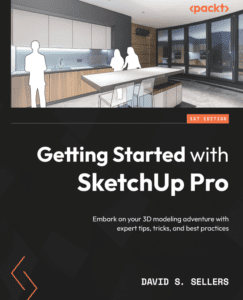David Sellers is the author of Getting Started with SketchUp Pro we got the chance to sit down with him and find out more about his experience of writing with Packt.
Q: How did you become an author for Packt? Tell us about your journey. What was your motivation for writing this book?
David: I have been working in the architectural industry and teaching software and architecture/construction for a few years. I had had the opportunity to review books for Packt in the past, and was happy to receive an offer to write an introduction to SketchUp Pro book when they asked!
I have developed and taught courses for SketchUp, and I am a certified 3D Warehouse Developer, but I had never attempted to write a textbook. This was a great first opportunity!
Q: What is the name of your book?
David: Getting Started with SketchUp Pro: Embark on your 3D modeling adventure with expert tips, tricks, and best practices
Q: What kind of research did you do, and how long did you spend researching before beginning the book?
David: I was already familiar with SketchUp, but I needed to dive deeper in order to feel prepared to write this book! SketchUp has some great help articles online and through help articles, forum posts, and a lot of exploration in the software I became familiar with every single tool in the SketchUp Pro interface!
It was quite the journey (especially when the software would go through updates) but I enjoyed the research process, and it helped me feel confident in this book.
Q: Do you have a blog that readers can follow?
David: I do not have a blog, but you can follow my school on LinkedIn. https://www.linkedin.com/school/vdci/
Q: What key takeaways do you want readers to come away with from the book?
David: SketchUp Pro is fun, accessible, and a great tool to design anything you can think to create!
Q: Can you share any blogs, websites and forums to help readers gain a holistic view of the tech they are learning?
David: SketchUp has a great article database with helpful tips and tricks: https://help.sketchup.com/en
Q. Did you face any challenges during the writing process? How did you overcome them?
David: I was attending graduate school while writing this book, and time management was a huge challenge.
I was able to quickly write the first few chapters as they were focused on best-practices and software principles, but as the chapters were getting longer and the content was becoming more dense it was a challenge to find consistent time to write.
My wife and I also welcomed our second child while I was writing this book, and that kept me tired and busy as well. Time was my friend, and with enough time I was able to return chapter after chapter to complete the book.
Q. How would you describe your author journey with Packt? Would you recommend Packt to aspiring authors?
David: Packt was patient and understanding of my circumstances. They will help with templating and process, but the content must all come from you. You must be a subject matter expert before starting to write a book – I would not suggest trying unless you are confident in yourself.
Q. Why should readers choose this book over others already on the market? How would you differentiate your book from its competition?
David: SketchUp is a tricky software to learn – especially when the fundamentals are not understood. Many books and online courses do not focus on the fundamentals of the software, which this book does! Understanding how SketchUp works is just as important as knowing how to use the tools, and we cover both early on in this book.
Q. What is/are your specialist tech area(s)?
David: Architecture, CAD, BIM, Visualization
Q. What advice would you give to readers jumping into this technology? Do you have any top tips?
David: This book was written for the Windows OS interface. I suggest using a Windows computer, and also a mouse with a scroll wheel. That will be very helpful in SketchUp and any 3D design software.
Q. What’s your take on the technologies discussed in the book? Where do you see these technologies heading in the future?
David: SketchUp Pro is a market-dominant software for the architecture, design, and visualization industries. SketchUp was just recently voted as the #1 design/BIM software by G2.com, and I do not see SketchUp losing it’s predominant position any time soon. SketchUp is expanding their integration with other BIM software and visualization software which will help them continue to succeed moving forward.
Q. How did you organize, plan, and prioritize your work and write the book?
David: I was working during the day, going to night classes, and writing the book after class and on the weekends. My schedule was volatile and I would not recommend it to anyone. I would recommend finding a time that you can spend during the day to write, and spend as much time with family on the weekends as possible.
Q. What are your favorite tech journals? How do you keep yourself up to date on tech?
David: I like to review the Journal of Architectural Education (JAE) and the Journal of Technology, Management, and Applied Engineering (JTMAE). https://www.jaeonline.org/pages/journal-architectural-education, https://www.atmae.org/page/JTMAEArticles
Q. Would you like to share your social handles? If so, mention them below.
David: Please find me on LinkedIn -> https://www.linkedin.com/in/david-sellers-aia-mba-515699ba/
Q: What is that one writing tip that you found most crucial and would like to share with aspiring authors?
David: For a technical book like this, just sit down and write! Overthinking without anything written down can be paralyzing. Writing and outline, rough draft, and revising drafts was helpful to get me through writer’s block.
You can find David’s book on Amazon by following this link: Please click here









